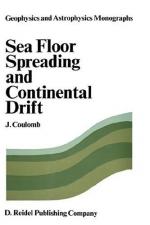|
This section contains 423 words (approx. 2 pages at 300 words per page) |

|
Earth's surface is composed of two kinds of crust, continental and oceanic. Most continental crust is over 3 billion years old, while virtually all oceanic crust is less than 180 million years old. Oceanic crust is young because it is continually destroyed in some places and created in others. Subduction is the process that destroys oceanic crust, and sea-floor spreading is the process that creates oceanic crust.
Sea-floor spreading is driven by crust formation along the mid-ocean ridges, meandering undersea mountain ranges that span Earth like the seams of a baseball. Oceanic crust is continually produced by magma welling up along the centerlines of the mid-ocean ridges. This new crust flows away from each ridgeline in two symmetric sheets, one on each side. The rate of sea-floor spreading resulting from this process is from 0.5 to 8 inches per year (1–20 cm/yr), depending on the particular mid-ocean ridge.
The Mid-Atlantic...
|
This section contains 423 words (approx. 2 pages at 300 words per page) |

|


